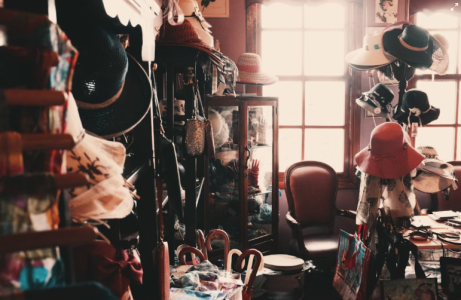“Swedish Death Cleaning” may be the most meaningful way to declutter your life
- Replies 0
At first glance, the name “Swedish Death Cleaning” might sound grim, but the practice is anything but bleak.
Instead, it’s a thoughtful and practical approach to organizing your life by clearing away unnecessary clutter before loved ones are left to do it for you.
Originating in Scandinavia, the method gained global attention after Margareta Magnusson’s bestselling book The Gentle Art of Swedish Death Cleaning and the Peacock series it inspired. Far from a trend, it’s a lifestyle shift rooted in kindness, simplicity, and intentional living.
The basics are straightforward: you go through your belongings and decide what truly matters to keep, what can be given away, and what should finally be discarded.
The goal isn’t to strip your life of joy but to make space for what you value most while easing future burdens for family members.
Imagine not leaving boxes of old holiday decorations, broken gadgets, or 30-year-old paperwork behind for someone else to sort through. Instead, you create clarity and peace—both for yourself now and for your loved ones later.
Experts recommend beginning with storage-heavy spaces like attics, basements, or garages—areas often packed with forgotten items.

Once you start reducing obvious clutter, like outdated clothing or unread stacks of books, it becomes easier to move through sentimental categories.
The process is less overwhelming when taken step by step, and it allows you to build momentum as you see progress. Each item cleared is not just a physical act of tidying but an emotional release as well.
Six guiding tips help make Swedish Death Cleaning effective and less intimidating. Start by removing excess—because no one really needs five serving platters or roller skates collecting dust.
Digitizing documents and photos is another game-changer, transforming mountains of paper into a single flash drive.
Also read: The secret to regifting without anyone knowing – Etiquette experts reveal!
Discarding with intention, not guilt, is central: donate what can be reused, recycle what you can, and release yourself from the weight of objects that no longer serve you.
Buying less is equally powerful, reminding us that fewer purchases now mean less clutter to manage later.
Consideration for others is also at the heart of the process. Talking openly with family about what you’re keeping or giving away prevents misunderstandings and gives them the chance to claim cherished items in advance.
Finally, it’s important to pace yourself. Decluttering an entire lifetime isn’t done overnight, and pushing too hard can leave the process feeling exhausting.
By treating it as an ongoing project filled with reflection and even joy, Swedish Death Cleaning becomes not a chore but a deeply meaningful act of self-care.
Also read: Is your phone clutter hiding a deeper issue? Find out what it could really mean
In the end, Swedish Death Cleaning isn’t about dwelling on mortality—it’s about living with intention.
It gives us permission to let go of the unnecessary while embracing the belongings and memories that truly reflect who we are.
By making these choices now, we lighten our own lives and leave behind not a burden, but a legacy of thoughtfulness.
Read next: Are you secretly sabotaging your own space? 5 decluttering rules organizers live by

Would you ever try Swedish Death Cleaning, even if you’re years away from needing it? Share your thoughts in the comments below.
Instead, it’s a thoughtful and practical approach to organizing your life by clearing away unnecessary clutter before loved ones are left to do it for you.
Originating in Scandinavia, the method gained global attention after Margareta Magnusson’s bestselling book The Gentle Art of Swedish Death Cleaning and the Peacock series it inspired. Far from a trend, it’s a lifestyle shift rooted in kindness, simplicity, and intentional living.
The basics are straightforward: you go through your belongings and decide what truly matters to keep, what can be given away, and what should finally be discarded.
The goal isn’t to strip your life of joy but to make space for what you value most while easing future burdens for family members.
Imagine not leaving boxes of old holiday decorations, broken gadgets, or 30-year-old paperwork behind for someone else to sort through. Instead, you create clarity and peace—both for yourself now and for your loved ones later.
Experts recommend beginning with storage-heavy spaces like attics, basements, or garages—areas often packed with forgotten items.

“Swedish Death Cleaning” may be the most meaningful way to declutter your life. Image source: Onur Bahçıvancılar / Unsplash
Once you start reducing obvious clutter, like outdated clothing or unread stacks of books, it becomes easier to move through sentimental categories.
The process is less overwhelming when taken step by step, and it allows you to build momentum as you see progress. Each item cleared is not just a physical act of tidying but an emotional release as well.
Six guiding tips help make Swedish Death Cleaning effective and less intimidating. Start by removing excess—because no one really needs five serving platters or roller skates collecting dust.
Digitizing documents and photos is another game-changer, transforming mountains of paper into a single flash drive.
Also read: The secret to regifting without anyone knowing – Etiquette experts reveal!
Discarding with intention, not guilt, is central: donate what can be reused, recycle what you can, and release yourself from the weight of objects that no longer serve you.
Buying less is equally powerful, reminding us that fewer purchases now mean less clutter to manage later.
Consideration for others is also at the heart of the process. Talking openly with family about what you’re keeping or giving away prevents misunderstandings and gives them the chance to claim cherished items in advance.
Finally, it’s important to pace yourself. Decluttering an entire lifetime isn’t done overnight, and pushing too hard can leave the process feeling exhausting.
By treating it as an ongoing project filled with reflection and even joy, Swedish Death Cleaning becomes not a chore but a deeply meaningful act of self-care.
Also read: Is your phone clutter hiding a deeper issue? Find out what it could really mean
In the end, Swedish Death Cleaning isn’t about dwelling on mortality—it’s about living with intention.
It gives us permission to let go of the unnecessary while embracing the belongings and memories that truly reflect who we are.
By making these choices now, we lighten our own lives and leave behind not a burden, but a legacy of thoughtfulness.
Read next: Are you secretly sabotaging your own space? 5 decluttering rules organizers live by
Key Takeaways
- Swedish Death Cleaning is a Scandinavian decluttering method focused on easing future burdens for loved ones.
- The process encourages keeping meaningful items while letting go of excess through donating, digitizing, or discarding.
- Starting with storage-heavy areas and pacing the process makes it more manageable and less overwhelming.
- At its core, the practice is about living intentionally, fostering reflection, and creating peace for yourself and your family.






